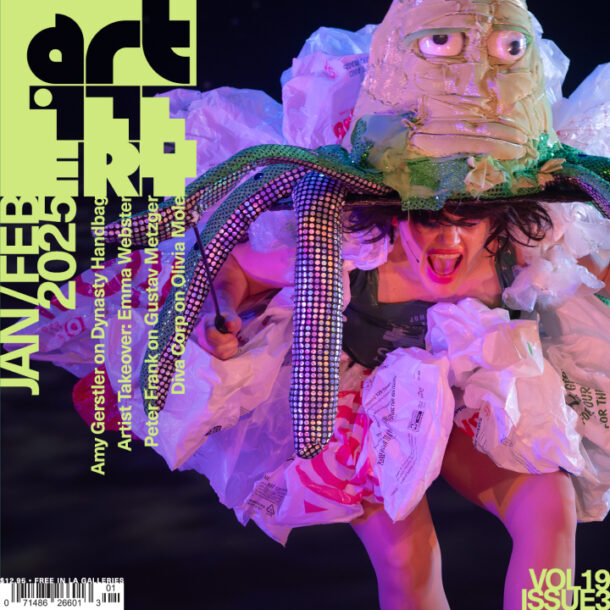I went in blind to David Hammons’ Concerto in Black and Blue (on view for the first time since its 2002 debut)—both literally and figuratively. When I pushed back the heavy curtain shrouding the gallery, darkness swallowed me. I couldn’t pull out my phone to navigate by its glow, nor could I use it to look up additional context for the exhibition—prior to entering, I had been asked to stow it in an automatically locking pouch. My only option was to switch on the miniature flashlight I had been provided and cast its blue beam before me in search of the show. Little did I know it had already begun.
Several other patrons, also wielding flashlights, materialized as I stumbled ahead. Had they come in from a separate entrance? Not quite—the gallery, it seemed, comprised several vast rooms, each one with sky-high ceilings. There were no signs or markers to direct us toward any predetermined path. We simply had to let the silence move us.
The Oxford New World Dictionary defines a concerto as “a musical composition for a solo instrument or instruments accompanied by an orchestra, especially one conceived on a relatively large scale.” The sole sounds in this concerto were hushed voices and the echo of footsteps against concrete. Yet the definition does offer a framework for interpretation: the solo instruments were the blue lights; the orchestra was the black background they played against.
The very presence of darkness suggests some hidden objects or entities; to obscure means to make dim as well as to conceal. It makes sense that I should instinctually anticipate some surprise. The next room, I was always sure, would contain a potential discovery: maybe a miniature in a far-off corner, or a stories-tall installation that would justify the exhibition’s scale. For a moment, my party believed we had found a sculpture, about the size and shape of a person; it turned out to be a living, breathing security guard, sentenced to standing still amidst our shuffling.
When you stare at nothing for long enough, everything becomes something. Soon, I was shifting my focus from the open space to its container. Minor irregularities on the walls held the significance of hieroglyphs. Electrical boxes could have contained clues. A floor-to-ceiling garage door proved particularly awe-inspiring: after beholding so much blankness, the textural interruption felt, well, orchestrated. I craned my neck, looking for cracks where the white light of the clouded March sky might have seeped in. I found none.
A full sweep of the premises revealed no secret totem. Making my meditative rounds, I felt a flicker of disappointment that my search should turn up dry—but had it really? Perhaps the perpetual craving for some tangible, cathartic conclusion is part of what Hammons set out to interrogate. In the tradition of John Cage’s 4’33” (1952), the absence of a spectacle can be a spectacle in and of itself. If a tree falls in the forest, does it really make a noise? If no blue lights bounce off the gallery floors, does the concerto play on?
It is tempting to view the show, all-consuming as it is, as its own entity apart from the world, but one experiences it anew when taking into account the artist’s prior interrogations into race and Blackness. Hammons is known for using color to reframe the viewer’s understanding of familiar images: his painting How Ya Like Me Now (1988) depicted Jesse Jackson with white skin and blond hair, while Untitled (African American Flag) (1990) presented an American flag in the red, green, and black of the Pan-African Universal Negro Improvement Association, founded in 1914. Additionally, Hammons has used negative space in sculptural installations to great effect: In the Hood (1993), which appeared on the cover of Claudia Rankine’s poetry collection Citizen (2014) in the wake of Trayvon Martin’s murder, consists of the hood from a hoodie nailed to a wall, the wearer absent or invisible. Considering all this, the piece reflects upon what it means to “see color”—not just an encounter with blackness, but an encounter with Blackness.
Much critical praise for Concerto in Black and Blue concludes by celebrating its collaborative nature: the intersection of flashlight beams becomes a gesture of intimacy or interrogation between strangers as their identities are subsumed by shadow in service of the art they’re unwittingly creating. Yet I’m more drawn to the work as a conscious collaboration with darkness. By restricting the sense by which we most typically experience art, Hammons forces us to look at what we can’t, or won’t, see.
David Hammons: Concerto in Black and Blue
Hauser & Wirth
901 E. 3rd St.,
Los Angeles, CA 90013
February 18 – May 25, 2025


